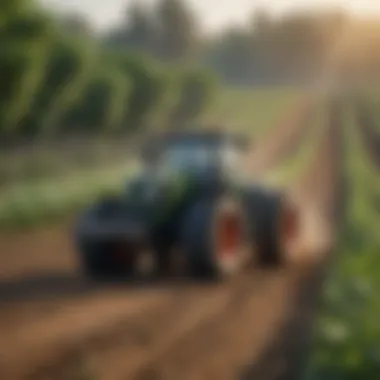Agriculture and Sustainability: The Future of Food


Intro
The relationship between agriculture and sustainability is becoming increasingly critical as the global population grows. With projections expecting the world's population to reach nearly 10 billion by 2050, there is a pressing need to reevaluate how food is produced. Sustainable agriculture practices offer a pathway to address this challenge, balancing productivity with the preservation of environmental resources. This article examines the methods and frameworks necessary for sustainable food production, focusing on contemporary issues like climate change and biodiversity loss that threaten current agricultural systems.
To understand the thrust of sustainable agriculture, it's essential to look closely at various practices and innovations that can support food production without exhausting natural resources. Technologies such as precision agriculture, organic farming, and agroforestry play crucial roles here. Additionally, this article will delve into policy implications, which are often overlooked but are essential for a framework oriented towards long-term sustainability. Community engagement also plays a significant part in fostering resilience and adaptability in agricultural practices.
This overview lays the groundwork for a more in-depth discussion of the components that make sustainable agriculture feasible and effective. By dissecting innovative strategies and their implementation, the aim is to create a comprehensive understanding of how modern agriculture can become environmentally sound while meeting the food security demands of future generations.
Intro to Agriculture and Sustainability
Understanding the intersection of agriculture and sustainability is crucial in today's context of global challenges. As the world population continues to increase, the pressure on agricultural systems intensifies. This makes it imperative to assess how agriculture practices can shift towards more sustainable methods that do not compromise future generations’ ability to produce food. In this article, we will navigate the complexities surrounding sustainable food production, examining the practices, innovations, and policies necessary to ensure food security while preserving the environment.
Defining Agriculture
Agriculture encompasses the practice of cultivating land, growing crops, and raising animals for food, fiber, and other products. Historically, agriculture has been a cornerstone of civilization, providing the basic sustenance necessary for survival. Modern agriculture has evolved into a highly mechanized and industrialized process, often prioritizing yield over environmental concerns. However, this approach has led to various detrimental effects, including soil degradation, water scarcity, and increased greenhouse gas emissions.
Understanding agriculture today requires a clear view of its ongoing transformation. It signifies not merely the production of food but a broader engagement with ecological systems, community livelihoods, and local economies. The way agriculture is practiced impacts not only farmers but also consumers, economies, and the planet as a whole.
Understanding Sustainability
Sustainability, in the context of agriculture, refers to practices that meet current food needs without compromising the ability of future generations to meet their own needs. Sustainable agriculture involves the careful management of resources for long-term viability. This can include a variety of practices that are environmentally sound, economically feasible, and socially responsible.
Key concepts within sustainability include:
- Ecological balance: Ensuring natural systems can regenerate while supporting agricultural practices.
- Resource efficiency: Minimizing waste and optimizing inputs like water and fertilizers.
- Social equity: Recognizing the rights and needs of all stakeholders in the agricultural sector.
The Importance of Sustainable Agriculture
The significance of sustainable agriculture cannot be overstated. It forms the foundation for achieving global food security as well as combating climate change. Here are several key benefits:
- Food Security: As agricultural methods become more resilient, communities can better withstand shocks from climate change or market fluctuations.
- Environmental Protection: Sustainable practices can help preserve biodiversity, protect natural habitats, and reduce pollution.
- Economic Resilience: By diversifying crops and utilizing renewable resources, farmers can enhance their economic stability.
In summary, the urgency of establishing sustainable agricultural practices is clear. Without a profound rethink of how we grow food, we will risk depleting resources and undermining future production. Thus, examining agriculture through the lens of sustainability allows for recognizing the interconnectedness of food systems, ecological health, and societal well-being.
"Sustainable agriculture integrates the three pillars of sustainability: economic viability, social equity, and environmental health."
Through this exploration, we set the stage to address current challenges, innovative practices, and the necessary policy frameworks that will lead us toward a more sustainable agricultural future.
Current Challenges in Agriculture
The landscape of agriculture today is fraught with significant challenges that threaten food security and sustainability. Understanding these challenges is essential for developing effective solutions. The key issues include climate change, resource depletion, and biodiversity loss. Each of these elements plays a crucial role in shaping agricultural practices and policies.
Climate Change Impacts
Climate change presents one of the most pressing challenges in agriculture. Rising temperatures, altered rainfall patterns, and increased frequency of extreme weather events disrupt traditional farming methods. Farmers must adapt their practices to recover from droughts, floods, and unpredictable seasonal changes. The effects are not merely environmental; they also have economic implications. Crop yields can decrease significantly, affecting food supply and increasing costs for consumers. Moreover, climate change can lead to a tense scenario of food scarcity. Thus, innovation and resilience in agricultural practices become paramount.
"The agricultural sector must respond to climate change with adaptive strategies to ensure food security."
Resource Depletion
Resource depletion refers to the exhaustion of essential natural resources. Water, soil, and fossil fuels are crucial for agriculture yet are increasingly overused. Over-extraction of water resources for irrigation lessens availability for other uses. This situation is compounded by pollution and degradation of soil from excessive chemical use. As a result, sustainable water management can't be overlooked. Farmers need to adopt recognition that conserving resources is vital. This not only improves the environment but can also enhance productivity in the long term.
Loss of Biodiversity


The loss of biodiversity in agricultural systems impacts ecosystem health. Diverse ecosystems provide numerous benefits, including pest control, pollination, and resilience to diseases. However, conventional farming practices often lead to monocultures, which reduce biodiversity. This poses a risk to food security, as crop failure can occur when environments change rapidly. Entering a new era, farmers must embrace variety in their planting strategies. Promoting diverse crop systems is essential for sustainability. Those strategies can help in building a buffer against pest invasions and diseases, ensuring a stable food supply.
Sustainable Agriculture Practices
Sustainable agriculture practices are crucial in reshaping food production systems for a more resilient future. They harness the natural ecosystem's principles to create systems that are both environmentally sound and economically viable. Implementing these practices can mitigate challenges posed by climate change, enhance biodiversity, and ensure that resources are utilized more efficiently. By adopting sustainable agriculture, farmers can achieve not only improved yields but also promote the welfare of their communities and the planet.
Crop Rotation and Diversification
Crop rotation is an age-old practice, recognized for its ability to improve soil health and fertility. By alternating different crops in a particular field over seasons, farmers can disrupt pest and disease cycles, reducing the need for chemical inputs. This method also enhances soil nutrients, as different crops utilize and replenish various nutrients.
Diversification goes hand-in-hand with crop rotation, encouraging the inclusion of multiple crops and varieties. This strategy mitigates risks associated with market fluctuations and pest outbreaks. For instance, planting legumes alongside cereals can enhance nitrogen availability in the soil, supporting the growth of subsequent crops. Adopting these practices leads to a more robust agricultural system that is less reliant on synthetic fertilizers and pesticides.
Organic Farming Techniques
Organic farming emphasizes the use of natural processes and materials, minimizing synthetic inputs. This approach not only cultivates fresh produce but also supports healthier ecosystems. Organic techniques include composting, using organic pest controls, and relying on crop rotation. These practices enhance soil health, promoting microbial diversity, which is essential for plant growth.
As organic products become more in demand, farmers engaging in organic practices may find better market prices for their goods, thus enhancing their economic status. Furthermore, organic farming addresses the concerns of climate change by reducing greenhouse gas emissions and improving carbon sequestration in the soil.
Agroecological Approaches
Agroecology combines ecological principles with agricultural practices to create sustainable farming systems. This holistic approach recognizes the interconnections between crops, livestock, and the environment. By designing productive ecosystems, agroecology promotes biodiversity, enhancing resilience against climate variability and pests.
Practices such as intercropping, agroforestry, and conservation grazing are part of agroecological systems. Farmers diversify their production, which not only increases resilience but also improves food security. For example, integrating livestock and vegetation can optimize land use, creating a sustainable feedback loop where plants benefit from animal waste, and animals benefit from plant cover.
Conservation Tillage
Conservation tillage involves reducing the frequency and intensity of soil tillage to preserve soil structure and health. This practice prevents soil erosion, improves water retention, and enhances microbial activity. By maintaining a cover of mulch or crop residue, farmers can protect the soil from adverse weather and promote nutrient cycling effectively.
The benefits are profound: increased soil organic matter leads to better fertility and enhanced carbon sequestration, mitigating climate change effects. Farmers who utilize conservation tillage can also reduce operating costs related to fuel and labor, providing a financially sustainable model.
Implementing sustainable agriculture practices can empower communities and protect ecosystems, contributing greatly to food security for future generations.
In summary, sustainable agriculture practices such as crop rotation, organic farming, agroecological approaches, and conservation tillage are vital strategies that support environmental health while ensuring productive food systems. These practices not only address current agricultural challenges but also pave the way for future innovations and sustainable development.
Technological Innovations in Sustainable Agriculture
Technological innovations are crucial in the evolution of sustainable agriculture. These advancements not only enhance productivity but also support environmental integrity. As the global population continues to rise, the pressure to meet food demands increases. Thus, integrating technology into farming practices becomes essential. This section discusses key innovations and their potential impacts on sustainable agriculture, focusing on precision agriculture, biotechnology, and sustainable water management technologies.
Precision Agriculture
Precision agriculture is a farming management concept that uses technology to monitor and manage soil variability in crops. Tools such as GPS, sensors, and data analytics allow farmers to optimize field-level management regarding crop farming. The benefits of precision agriculture include improved yield, reduced waste of resources, and minimized environmental impacts.
The use of drones and satellite imagery can inform farmers about crop health, soil conditions, and moisture levels. By utilizing this data, farmers can make informed decisions about the timing and amount of inputs like water, fertilizers, and pesticides. This technology not only helps in enhancing productivity but also conserves resources and reduces the ecological footprint.
Biotechnology and Genetic Engineering
Biotechnology and genetic engineering involve manipulating organisms at the molecular level to create crops with desirable traits. These innovations can lead to higher yields, resistance to pests, and reduced reliance on chemical inputs. For example, genetically modified organisms (GMOs) can be engineered to tolerate harsh conditions like drought, which is critical in a changing climate.
However, the use of biotechnology comes with debates. Critics often raise concerns about biodiversity and the potential long-term effects on ecosystems. It is crucial for policymakers to establish regulations that ensure safety and sustainability in using these technologies. Educating farmers on their benefits and risks is also necessary to foster responsible adoption.
Sustainable Water Management Technologies
Water scarcity poses a significant threat to agricultural productivity. As such, sustainable water management technologies are vital. Techniques such as drip irrigation and rainwater harvesting capture and conserve water efficiently. These systems allow for the precise delivery of water directly to the root zone of plants, reducing evaporation and runoff.


Integrating smart technologies that monitor moisture levels in the soil can further optimize water usage. Automated systems can provide real-time data, ensuring that crops receive the right amount of water at the right time. This not only boosts crop health but also conserves valuable water resources.
Policy and Regulatory Frameworks
The frameworks surrounding policy and regulations play a significant role in shaping sustainable agriculture. They help create an environment where sustainable practices can flourish. These frameworks establish the rules and guidelines that govern agricultural activities. A robust policy framework is essential to ensure that sustainability is prioritized. It encourages the adoption of eco-friendly methods while balancing the needs of farmers and the environment.
Effective policy frameworks can lead to numerous benefits. They can augment food security, support local economies, and mitigate environmental impacts. Policies can also incentivize innovation in agricultural practices that respect both the land and the communities that rely on it. Moreover, these frameworks have a role in addressing inequities within the agricultural system, ensuring all stakeholders have a voice in sustainability efforts.
However, crafting sound policy is not without challenges. Variability in governance structures and agricultural priorities across different regions can complicate the implementation. Additionally, policymakers must consider the economic implications for farmers. Balancing environmental goals with the needs of the agricultural sector requires careful thought and planning.
Government Support for Sustainable Practices
Government support is vital to the success of sustainable agriculture initiatives. This support can come in various forms such as financial assistance, research funding, and educational programs. Governments worldwide are beginning to prioritize sustainability more than ever before, driven by the pressing challenges posed by climate change and resource depletion.
Subsidies for sustainable farming can alleviate some of the economic burdens associated with transitioning from traditional methods to more eco-friendly practices. These financial incentives motivate farmers to try new techniques, such as organic farming or crop rotation. Moreover, providing training and resources enhances farmers’ understanding of sustainable practices, which can be crucial for long-term success.
International Agreements and Initiatives
International cooperation is key to addressing global agricultural challenges. Agreements like the Paris Agreement focus on reducing agriculture's carbon footprint. These initiatives create frameworks within which countries can collaborate to achieve sustainability goals.
Global organizations often play a significant role in promoting these agreements. The United Nations’ Food and Agriculture Organization (FAO) actively works to establish best practices for sustainable agriculture worldwide. Countries engaging in such collaborations benefit from shared knowledge, technology transfer, and coordinated efforts to tackle common problems.
Local Governance in Agricultural Sustainability
Local governance structures are essential for implementing sustainable practices at the community level. They can tailor policies to fit the specific needs of the region. Local initiatives allow for direct participation from community members, thereby fostering a sense of responsibility toward sustainable practices.
Local governments often partner with local farmers and educational institutions. These partnerships can provide valuable insights into the types of solutions that will be most effective in specific local circumstances. By engaging the community, local governance can promote initiatives that address immediate concerns while keeping long-term sustainability in mind.
Local governance can align agricultural practices with community values, ensuring more sustainable food systems.
In summary, policy and regulatory frameworks are foundational to advancing sustainable agriculture. From government support to international agreements and local governance, these structures help facilitate the necessary changes in our agricultural systems. By embracing these frameworks, we can work towards a more sustainable future for our food production.
Community Engagement and Education
Community engagement and education hold a pivotal role in the promotion of sustainable agriculture. It invites participation from various stakeholders, including local farmers, consumers, educators, and policymakers. Engaging with local communities fosters an environment where sustainable practices can be shared, adopted, and enhanced. The benefits of this engagement are multi-faceted and create a strong basis for sustainable food production strategies.
The Role of Local Communities
Local communities are essential in the journey towards sustainable agriculture. Each community possesses unique knowledge about their environment, traditions, and agricultural practices. This local insight can lead to innovative approaches tailored to specific challenges. When communities collaborate, they can implement practices that reflect their cultural values while addressing sustainability challenges.
- Grassroots Initiatives: Community-led projects often unveil new methods that are both environmentally friendly and economically viable. For instance, initiatives such as community gardens encourage biodiversity and provide local food sources.
- Cultural Relevance: Local customs can inform sustainable practices, making them more acceptable and effective. Many regions have traditional practices that promote conservation without the need for modern alternatives.
Communities can mobilize quickly when they unite for a common goal. They can advocate for policies that favor sustainable practices and push for resources that support local farmers. An example of this is how local advocacy groups play roles in policy changes that promote sustainable farming techniques.
Educational Initiatives for Sustainable Practices
Education is instrumental in enabling communities to adopt sustainable agricultural practices. By increasing awareness about sustainable methods, local groups can significantly impact the overall effectiveness of food production systems. Educational programs can range from workshops to formal training, targeting various age groups and demographics.
- Workshops for Farmers: Practical training sessions can show farmers different sustainable methods like minimal-tillage or polyculture planting. Hands-on experiences help in understanding the benefits of these techniques.
- School Programs: Introducing agricultural education in schools creates awareness from a young age. Students learn about where their food comes from and the importance of sustainability. This early engagement promotes a generation aware of environmental issues.
"Education in sustainability is not just about theory; it is about practice and community involvement."
These initiatives often rely on collaboration between various organizations, such as universities, local governments, and NGOs. Together, they can provide the necessary resources for effective education while adapting content to local contexts.


Building Support Networks
Building support networks is crucial for the success of sustainable agriculture initiatives. These networks connect farmers, educators, researchers, and consumers. When people come together sharing their resources, experiences, and challenges, they create a strong foundation for progress.
- Networking Events: Conferences and workshops can serve as effective platforms for sharing knowledge. Farmers can communicate their successes and challenges to one another, leading to collective problem-solving.
- Online Platforms: Social media and community forums offer spaces for ongoing discussion and support. Websites like Reddit allow individuals to seek advice and share stories, contributing to a larger knowledge base.
Support networks not only enhance practical knowledge but also create a community of like-minded individuals devoted to sustainability. These relationships foster stronger commitments to sustainable practices and increase the likelihood of long-term success in sustainability efforts.
Engaging with communities and providing education is imperative in shaping the future of sustainable agriculture. By working together, leveraging local knowledge, and building networks, sustainable practices can thrive, ensuring food security and environmental health for generations to come.
Future Directions in Sustainable Agriculture
Sustainable agriculture is at a critical juncture, where its future directions must be carefully considered. This section examines evolving strategies that can ensure food production adapts to changing environmental and societal needs. Emphasizing the significance of these future directions in sustainable practices opens pathways for enhancing food security, conserving natural resources, and maintaining biodiversity. These strategies are essential as they highlight the intricate link between human activity and environmental stewardship.
Adapting to Climate Change
Adaptation to climate change is paramount for the long-term viability of agriculture. As climate patterns shift, farmers must adjust their practices accordingly. Changes may include adopting drought-resistant crops, modifying planting schedules, and improving soil health through organic inputs.
Notably, regenerative agriculture focuses on restoring soil organic matter, providing resilience against climate impacts. This method not only supports crop yields but also enhances carbon sequestration, helping to mitigate climate change.
The importance lies in a proactive approach, where farmers collaborate with scientists to develop climate-resilient varieties. This concerted effort underscores the critical role of research and innovation in adapting agriculture to a fluctuating climate.
Innovative Practices on the Horizon
Innovative practices are emerging as valuable components of sustainable agriculture. One such innovation is vertical farming, which uses technology to grow crops in stacked layers. This method conserves land and water, thus addressing the challenges of urbanization and resource scarcity. Hydroponics and aeroponics are two techniques gaining traction. They reduce water usage compared to traditional farming methods and yield high crop outputs.
Additionally, agroforestry integrates trees and shrubs into farming systems, promoting biodiversity and improving ecosystem services.
Investments in research and development will likely yield more breakthroughs that address food security and sustainability challenges.
By prioritizing these innovations, the agricultural sector can achieve a balance between productivity and sustainability.
Integrating Technology and Nature
The integration of technology into agricultural practices presents new opportunities to enhance sustainability. Precision agriculture technologies—such as GPS and remote sensing—enable farmers to monitor field variability and optimize inputs like water and fertilizers. This targeted approach reduces waste and minimizes environmental impact.
Moreover, data analytics can provide insights into crop performance, leading to informed decision-making. Using machine learning algorithms, farmers can predict outcomes and adjust their practices based on real-time data.
Such integrations promote a synergy between technology and nature, creating a more efficient and sustainable food production system.
In summary, navigating the future of agriculture requires a multifaceted approach that adapts to climate change, employs innovative practices, and harmonizes technology with nature. This forward-thinking mindset will not only secure food production but also support environmental health for generations to come.
"Adapting agricultural practices to sustain our environment is not just a necessity but an opportunity to innovate and collaborate for a better future."
Learn more about sustainable agriculture here
Explore innovations in precision agriculture at Britannica
Join discussions on sustainable farming practices on Reddit
Stay connected with agriculture communities on Facebook
End
In the exploration of agriculture and sustainability, the conclusion serves as a crucial synthesis of the entire discourse. It reflects on the various dimensions of sustainable agriculture practices while encapsulating the key insights gained throughout the article. The critical examination of sustainable agriculture reveals the intrinsic link between effective food production and environmental stewardship. As the world faces monumental challenges like climate change and resource depletion, recognizing the importance of a balanced agricultural approach becomes paramount.
Summary of Key Points
To recap, several pivotal areas were discussed:
- Current Challenges: Climate change, resource depletion, and biodiversity loss pose significant threats to traditional agricultural practices.
- Sustainable Practices: Techniques such as crop rotation, organic farming, and agroecological approaches emerge as vital strategies for sustainable food production.
- Technological Innovations: Advancements in precision agriculture and biotechnology introduce efficiencies that can mitigate environmental impacts while increasing yields.
- Policy Frameworks: Government initiatives and international agreements play a fundamental role in supporting sustainable agriculture practices.
- Community Engagement: Local involvement and education foster a deeper understanding of sustainability, empowering communities to adopt practices that enhance food security.
With these key points in mind, the multifaceted nature of sustainable agriculture is more apparent, as is the interconnectedness of various factors involved in food production.
The Path Forward for Agriculture and Sustainability
Looking ahead, the path toward achieving a sustainable agricultural future requires concerted efforts on various fronts. Transitioning to sustainable practices will necessitate a commitment from producers, policymakers, and consumers alike.
Here are several considerations for moving forward:
- Innovative Practices: Continuous research and development should focus on emerging sustainable technologies, and practices that can adapt to evolving agricultural needs.
- Strenghtening Policies: Supportive policies must be drafted to encourage farmers to adopt sustainable methods, including financial incentives and technical assistance.
- Public Awareness: Increasing awareness about the benefits of sustainable agriculture will foster a culture of environmental responsibility among consumers.
- Collaboration: Cross-sector collaboration among government, academic institutions, and private industry will be essential for sharing knowledge and resources.
"To achieve food security and sustainability, the integration of innovative methods and active community participation is essential."
Each of these elements will significantly contribute to a robust agricultural framework that aligns productivity with sustainability, ensuring the ability to meet global food needs without compromising environmental integrity.















